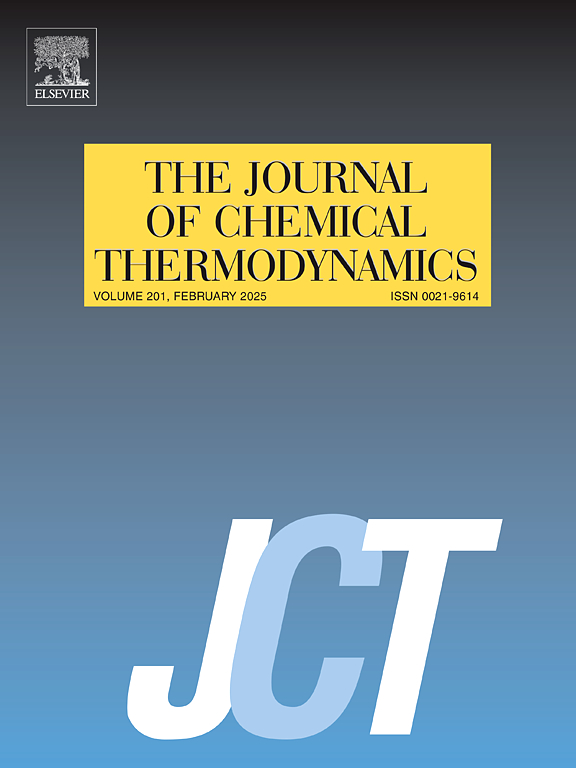Investigation of the behavior of methyl octanoate and 2-alkanol mixtures: Evaluating the friction theory
IF 2.2
3区 工程技术
Q3 CHEMISTRY, PHYSICAL
引用次数: 0
Abstract
This study investigated the volumetric and viscous properties of binary mixtures composed of methyl octanoate (MO) and a series of 2-alkanols (ranging from C3 to C6) across a temperature range of 293.15 to 323.15 K. Experimental analysis indicated positive excess molar volumes and negative viscosity deviations, suggesting comparatively weak intermolecular interactions between MO and the 2-alkanol molecules. The observed positive excess molar volumes suggest that the mixing process results in an expansion, potentially due to disruption of self-associated structures within the pure components. Conversely, the negative viscosity deviations indicate a decrease in resistance to flow compared to ideal mixing, further supporting the notion of reduced cohesive forces in the mixtures. To further elucidate the mixture behavior and provide a predictive capability, the Friction theory (f-theory) was employed to model the viscosity of the mixtures. The model exhibited a high degree of accuracy, with a maximum discrepancy of only 2.32 % observed for the MO + 2-hexanol system. This close agreement between the theoretical predictions and experimental data underscores the utility of the f-theory as a robust tool for predicting the rheological behavior of these binary mixtures, offering potential applications in fields such as chemical process design and optimization.
辛酸甲酯和2-烷醇混合物的行为研究:摩擦理论的评价
本文研究了由辛酸甲酯(MO)和一系列2-烷醇(从C3到C6)组成的二元混合物在293.15至323.15 K温度范围内的体积和粘性特性。实验分析表明,MO与2-烷醇分子之间的分子间相互作用相对较弱,过量摩尔体积为正,粘度偏差为负。观察到的正过量摩尔体积表明,混合过程导致了膨胀,这可能是由于纯组分内部自相关结构的破坏。相反,与理想混合相比,负粘度偏差表明流动阻力降低,进一步支持混合物中凝聚力降低的概念。为了进一步阐明混合物的行为并提供预测能力,采用摩擦理论(f理论)来模拟混合物的粘度。该模型具有较高的精度,MO + 2-己醇体系的最大误差仅为2.32%。理论预测和实验数据之间的这种密切一致强调了f理论作为预测这些二元混合物流变行为的强大工具的实用性,在化学过程设计和优化等领域提供了潜在的应用。
本文章由计算机程序翻译,如有差异,请以英文原文为准。
求助全文
约1分钟内获得全文
求助全文
来源期刊

Journal of Chemical Thermodynamics
工程技术-热力学
CiteScore
5.60
自引率
15.40%
发文量
199
审稿时长
79 days
期刊介绍:
The Journal of Chemical Thermodynamics exists primarily for dissemination of significant new knowledge in experimental equilibrium thermodynamics and transport properties of chemical systems. The defining attributes of The Journal are the quality and relevance of the papers published.
The Journal publishes work relating to gases, liquids, solids, polymers, mixtures, solutions and interfaces. Studies on systems with variability, such as biological or bio-based materials, gas hydrates, among others, will also be considered provided these are well characterized and reproducible where possible. Experimental methods should be described in sufficient detail to allow critical assessment of the accuracy claimed.
Authors are encouraged to provide physical or chemical interpretations of the results. Articles can contain modelling sections providing representations of data or molecular insights into the properties or transformations studied. Theoretical papers on chemical thermodynamics using molecular theory or modelling are also considered.
The Journal welcomes review articles in the field of chemical thermodynamics but prospective authors should first consult one of the Editors concerning the suitability of the proposed review.
Contributions of a routine nature or reporting on uncharacterised materials are not accepted.
 求助内容:
求助内容: 应助结果提醒方式:
应助结果提醒方式:


